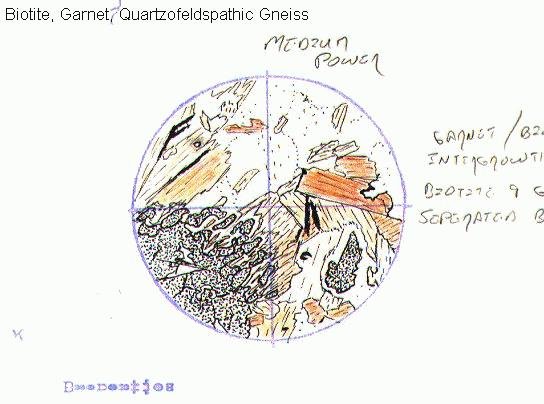Biotite Garnet Quartz Feldspar Gneiss

This sample consists of biotite in browns, almandine garnet, a denser "high-relief" mineral, minor amounts of magnetite which is opaque and black in transmitted light, and quarts and feldspar as in the first slide. In this section shows important disequilibrium textures between the biotite and garnet crystals. In every case the two minerals are separated by a rim of plagioclase. This allows an accurate estimation of the conditions under which this sample existed by noting the reaction chemistry between the two minerals biotite and garnet. In this case the garnet is growing at the biotite's expense. These reactions only occure under very high conditions of temperature and pressure indicating deep burial.
Metamorphic rock naming convention: first minor or accessory minerals, second main rock-forming minerals, thirdly rock texture, (geniss or granulite in my case).
My Master's Thesis consisted of mapping, collecting, studying, and analysing numerous rock types from a small area of Southwest Montana. The analysis revealed the area to be an ancient terrain formed originally as sediments deposited in an open marien shelf setting prior to 2.8 billion years ago. By 2.8 Billion Years ago the section had already been very deeply buried in an active tectonic zone. The original sediments, under extreme conditions of temperature and pressure, were folded and changed, the crystals growing new minerals stable under the conditions, and resetting geolgic clock to that event. The section has largely remained stable from that time until recent. At about 1.6 Billion years the region was uplifted and the unroofing caused some retrograde mineral changes and certain areas adjusted to conditions lf lower temperature and pressure. In my thesis area the mineralogy largly escaped this event, probably due to the extreme dryness of the minerology. Ions simply were unable to migrate and reform new minerals.
My study was to document these ancient events and to determine, via study of the minerology, the conditions of temperature and pressure under which these minerals originally formed and to find evidence, if possible, of the original sedimentary nature of the section.
kjs
For those interested in the bitter detail on the petrology and origin of Gneiss and associated rocks, at least from one specific ancient locality, see my
Master's Thesis....
Go back....

